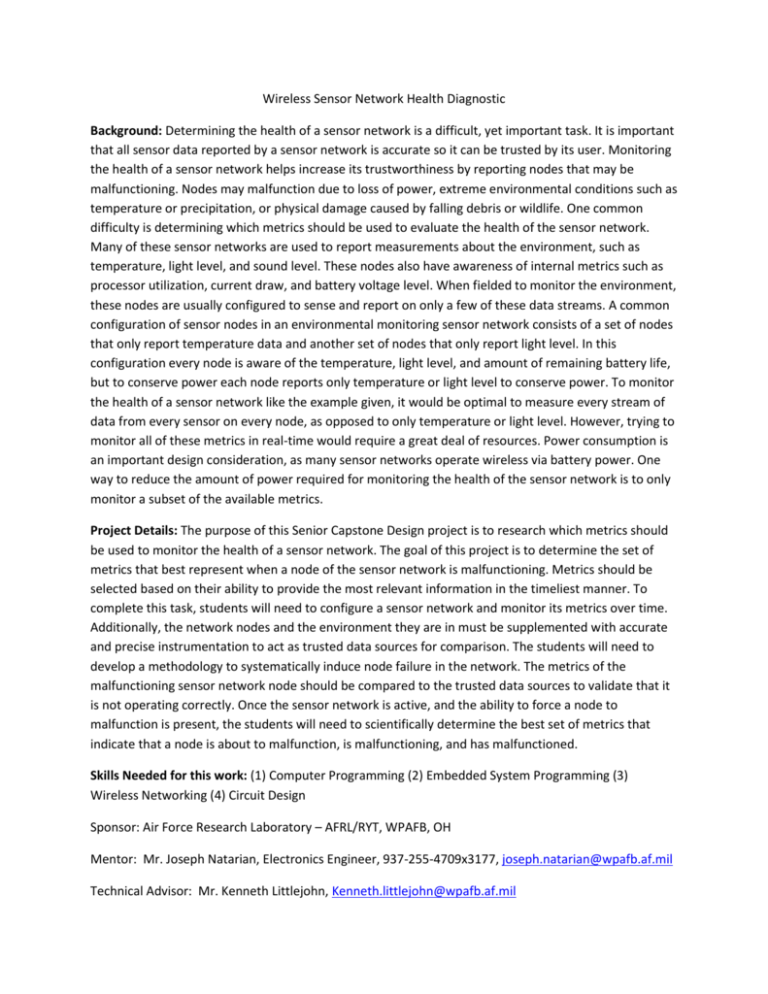Wireless Sensor Network Health Diagnostic
advertisement

Wireless Sensor Network Health Diagnostic Background: Determining the health of a sensor network is a difficult, yet important task. It is important that all sensor data reported by a sensor network is accurate so it can be trusted by its user. Monitoring the health of a sensor network helps increase its trustworthiness by reporting nodes that may be malfunctioning. Nodes may malfunction due to loss of power, extreme environmental conditions such as temperature or precipitation, or physical damage caused by falling debris or wildlife. One common difficulty is determining which metrics should be used to evaluate the health of the sensor network. Many of these sensor networks are used to report measurements about the environment, such as temperature, light level, and sound level. These nodes also have awareness of internal metrics such as processor utilization, current draw, and battery voltage level. When fielded to monitor the environment, these nodes are usually configured to sense and report on only a few of these data streams. A common configuration of sensor nodes in an environmental monitoring sensor network consists of a set of nodes that only report temperature data and another set of nodes that only report light level. In this configuration every node is aware of the temperature, light level, and amount of remaining battery life, but to conserve power each node reports only temperature or light level to conserve power. To monitor the health of a sensor network like the example given, it would be optimal to measure every stream of data from every sensor on every node, as opposed to only temperature or light level. However, trying to monitor all of these metrics in real-time would require a great deal of resources. Power consumption is an important design consideration, as many sensor networks operate wireless via battery power. One way to reduce the amount of power required for monitoring the health of the sensor network is to only monitor a subset of the available metrics. Project Details: The purpose of this Senior Capstone Design project is to research which metrics should be used to monitor the health of a sensor network. The goal of this project is to determine the set of metrics that best represent when a node of the sensor network is malfunctioning. Metrics should be selected based on their ability to provide the most relevant information in the timeliest manner. To complete this task, students will need to configure a sensor network and monitor its metrics over time. Additionally, the network nodes and the environment they are in must be supplemented with accurate and precise instrumentation to act as trusted data sources for comparison. The students will need to develop a methodology to systematically induce node failure in the network. The metrics of the malfunctioning sensor network node should be compared to the trusted data sources to validate that it is not operating correctly. Once the sensor network is active, and the ability to force a node to malfunction is present, the students will need to scientifically determine the best set of metrics that indicate that a node is about to malfunction, is malfunctioning, and has malfunctioned. Skills Needed for this work: (1) Computer Programming (2) Embedded System Programming (3) Wireless Networking (4) Circuit Design Sponsor: Air Force Research Laboratory – AFRL/RYT, WPAFB, OH Mentor: Mr. Joseph Natarian, Electronics Engineer, 937-255-4709x3177, joseph.natarian@wpafb.af.mil Technical Advisor: Mr. Kenneth Littlejohn, Kenneth.littlejohn@wpafb.af.mil






